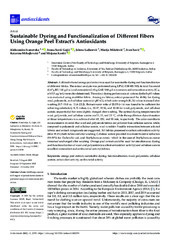Приказ основних података о документу
Sustainable Dyeing and Functionalization of Different Fibers Using Orange Peel Extract’s Antioxidants
| dc.creator | Ivanovska, Aleksandra | |
| dc.creator | Gajić Savić, Ivana | |
| dc.creator | Lađarević, Jelena | |
| dc.creator | Milošević, Marija | |
| dc.creator | Savić, Ivan | |
| dc.creator | Mihajlovski, Katarina | |
| dc.creator | Kostić, Mirjana | |
| dc.date.accessioned | 2022-11-03T09:51:51Z | |
| dc.date.available | 2022-11-03T09:51:51Z | |
| dc.date.issued | 2022 | |
| dc.identifier.issn | 2076-3921 | |
| dc.identifier.uri | http://TechnoRep.tmf.bg.ac.rs/handle/123456789/5237 | |
| dc.description.abstract | A diluted ethanol orange peel extract was used for sustainable dyeing and functionalization of different fabrics. The extract analysis was performed using UPLC-ESI-MS/MS; its total flavonoid (0.67 g RE/100 g d.w.) and antioxidant (2.81 g GAE/100 g d.w.) contents and antioxidant activity (IC50 of 65.5 µg/mL) were also determined. The extract dyeing performance at various dyebath pH values was evaluated using multifiber fabric. Among six fabrics, extract possessed the ability for dyeing wool, polyamide, and cellulose acetate (at pH 4.5), which color strength (K/S) values increased after washing (9.7–19.8 vs. 11.6–23.2). Extract:water ratio of 20:35 (v/v) was found to be sufficient for achieving satisfactory K/S values (i.e., 20.17, 12.56, and 10.38 for wool, polyamide, and cellulose acetate, respectively) that were slightly changed after washing. The optimal dyeing temperatures for wool, polyamide, and cellulose acetate are 55, 35, and 25 °C, while the equilibrium dye exhaustion at those temperatures was achieved after 45, 120, and 90 min, respectively. The color coordinate measurements revealed that wool and polyamide fabrics are yellower than cellulose acetate, while, compared to polyamide and cellulose acetate, wool is redder. Possible interactions between selected fabrics and extract compounds are suggested. All fabrics possessed excellent antioxidant activity (88.6–99.6%) both before and after washing. Cellulose acetate provided maximum bacterial reduction (99.99%) for Escherichia coli, and Staphylococcus aureus, which in the case of Staphylococcus aureus remained unchanged after washing. Orange peel extract could be used for simultaneous dyeing and functionalization of wool and polyamide (excellent antioxidant activity) and cellulose acetate (excellent antioxidant and antibacterial activity) fabrics. | sr |
| dc.language.iso | en | sr |
| dc.publisher | MDPI | sr |
| dc.relation | info:eu-repo/grantAgreement/MESTD/inst-2020/200133/RS// | sr |
| dc.relation | info:eu-repo/grantAgreement/MESTD/inst-2020/200135/RS// | sr |
| dc.relation | info:eu-repo/grantAgreement/MESTD/inst-2020/200287/RS// | sr |
| dc.rights | openAccess | sr |
| dc.rights.uri | https://creativecommons.org/licenses/by/4.0/ | |
| dc.source | Antioxidants | sr |
| dc.subject | antibacterial activity | sr |
| dc.subject | antioxidant activity | sr |
| dc.subject | cellulose acetate | sr |
| dc.subject | functionalization | sr |
| dc.subject | orange peel extract | sr |
| dc.subject | polyamide | sr |
| dc.subject | sustainable dyeing | sr |
| dc.subject | wool | sr |
| dc.title | Sustainable Dyeing and Functionalization of Different Fibers Using Orange Peel Extract’s Antioxidants | sr |
| dc.type | article | sr |
| dc.rights.license | BY | sr |
| dc.citation.issue | 10 | |
| dc.citation.rank | aM21~ | |
| dc.citation.spage | 2059 | |
| dc.citation.volume | 11 | |
| dc.identifier.doi | 10.3390/antiox11102059 | |
| dc.identifier.fulltext | http://TechnoRep.tmf.bg.ac.rs/bitstream/id/12940/bitstream_12940.pdf | |
| dc.identifier.scopus | 2-s2.0-85140440805 | |
| dc.type.version | publishedVersion | sr |

